

Elliptic Curves as Elementary Equations. Finding solutions to systems of polynomial equations is one of the oldest and deepest problems in all of mathematics.
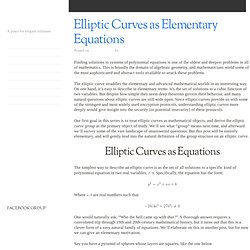
This is broadly the domain of algebraic geometry, and mathematicians wield some of the most sophisticated and abstract tools available to attack these problems. The elliptic curve straddles the elementary and advanced mathematical worlds in an interesting way. On one hand, it’s easy to describe in elementary terms: it’s the set of solutions to a cubic function of two variables. But despite how simple they seem deep theorems govern their behavior, and many natural questions about elliptic curves are still wide open.
Since elliptic curves provide us with some of the strongest and most widely used encryption protocols, understanding elliptic curves more deeply would give insight into the security (or potential insecurity) of these protocols. Darwin Week 2012 - Lawrence Krauss: "A Universe from Nothing" No Military Funding. I don't take funding from military agencies.
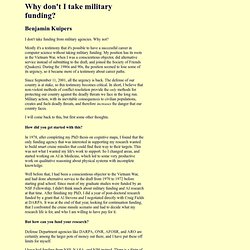
Why not? Mostly it's a testimony that it's possible to have a successful career in computer science without taking military funding. My position has its roots in the Vietnam War, when I was a conscientious objector, did alternative service instead of submitting to the draft, and joined the Society of Friends (Quakers). Should Scientists and Engineers Resist Taking Military Money? In 2005, I became, briefly, a tool of the military-industrial complex.
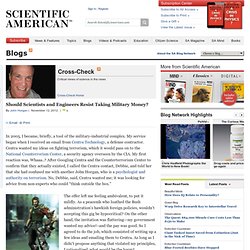
My service began when I received an email from Centra Technology, a defense contractor. Centra wanted my ideas on fighting terrorism, which it would pass on to the National Counterrorism Center, a security agency overseen by the CIA. My first reaction was, Whaaa..? After Googling Centra and the Counterterrorism Center to confirm that they actually existed, I called the Centra contact, Debbie, and told her that she had confused me with another John Horgan, who is a psychologist and authority on terrorism. Tensors for Engineers. Biology of Consciousness.
Integrated information theory. Integrated information theory is a theoretical framework for attempting to understand and explain the nature of consciousness.

It was developed by psychiatrist and neuroscientist Giulio Tononi of the University of Wisconsin–Madison.[1] Overview[edit] Schematic diagram of how to decompose systems into overlapping complexes according to Tononi's information integration theory. Global Workspace Theory. Global Workspace Theory (GWT) is a simple cognitive architecture that has been developed to account qualitatively for a large set of matched pairs of conscious and unconscious processes.
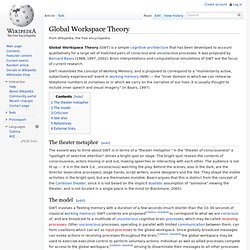
It was proposed by Bernard Baars (1988, 1997, 2002). Brain interpretations and computational simulations of GWT are the focus of current research. GWT resembles the concept of Working Memory, and is proposed to correspond to a "momentarily active, subjectively experienced" event in working memory (WM) –-- the "inner domain in which we can rehearse telephone numbers to ourselves or in which we carry on the narrative of our lives. It is usually thought to include inner speech and visual imagery. " (in Baars, 1997). [edit] The model[edit] Primary consciousness. Conversely, higher order consciousness can be described as being "conscious of being conscious"; it is accompanied by reflective thought and includes a past as well as speculation about the future.
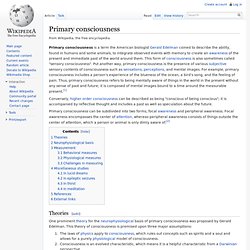
Primary consciousness can be subdivided into two forms, focal awareness and peripheral awareness. Focal awareness encompasses the center of attention, whereas peripheral awareness consists of things outside the center of attention, which a person or animal is only dimly aware of.[2] Theories[edit] One prominent theory for the neurophysiological basis of primary consciousness was proposed by Gerald Edelman. Human hearing beats the Fourier uncertainty principle. (Phys.org)—For the first time, physicists have found that humans can discriminate a sound's frequency (related to a note's pitch) and timing (whether a note comes before or after another note) more than 10 times better than the limit imposed by the Fourier uncertainty principle.

Not surprisingly, some of the subjects with the best listening precision were musicians, but even non-musicians could exceed the uncertainty limit. The results rule out the majority of auditory processing brain algorithms that have been proposed, since only a few models can match this impressive human performance. The researchers, Jacob Oppenheim and Marcelo Magnasco at Rockefeller University in New York, have published their study on the first direct test of the Fourier uncertainty principle in human hearing in a recent issue of Physical Review Letters. An ear for precision But as it turns out, the subjects could discriminate both types of sounds with equally impressive performance. New sound models.
Edge.org. DEEP PRAGMATISM. For the last 20 years I have been trying to understand morality.
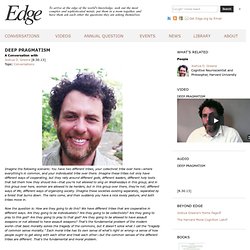
You can think of morality as having two basic questions. WHAT IS THE COMMON GROUND BETWEEN ART AND SCIENCE? AND HOW IS BEETHOVEN LIKE DARWIN? Www.sns.ias.edu/~arkani/pdfs/FundamentalPhys.pdf. Observation of Bose-Einstein Condensation in a Dilute Atomic Vapor. Lockhart's Lament. The Need for Belonging in Math and Science. From her earliest memories, Catherine Good was good at math.

By second grade she was performing at the fourth grade level, sometimes even helping the teacher grade other students’ work. She was praised constantly for her “gift”, often overhearing her mother tell anyone who would listen that she was a “sponge” for anything mathematical.